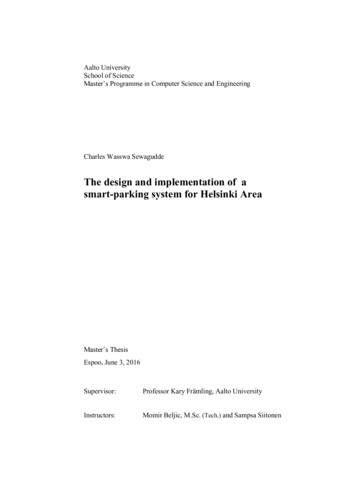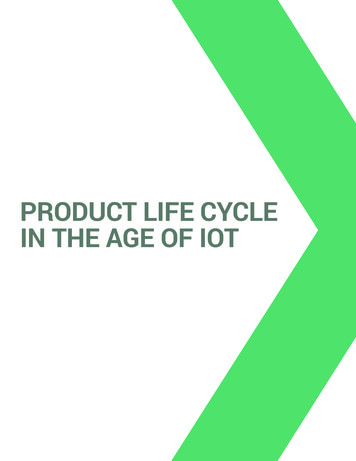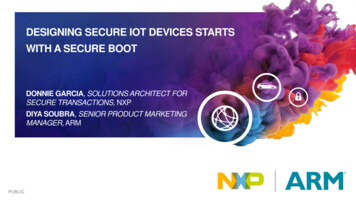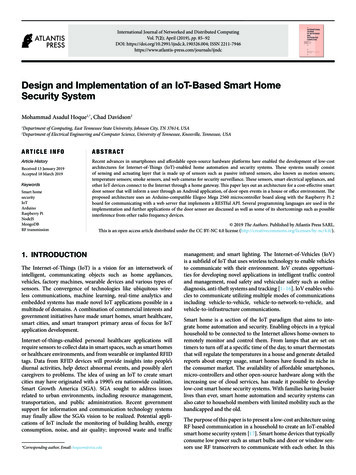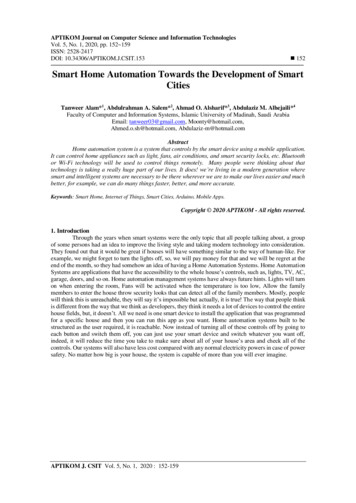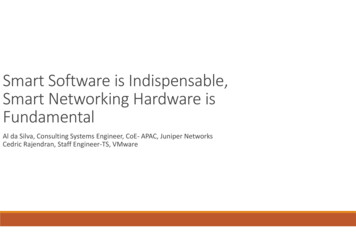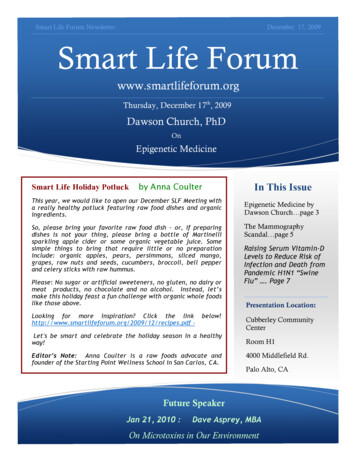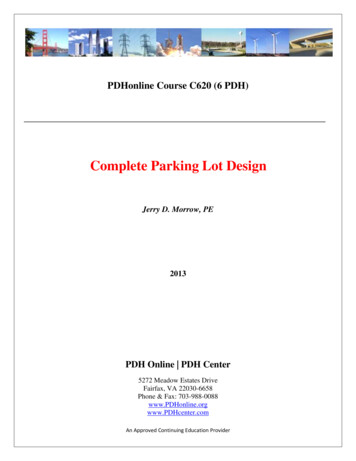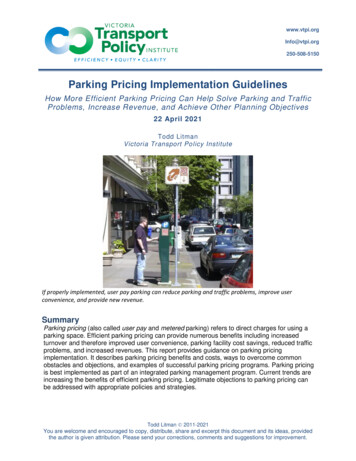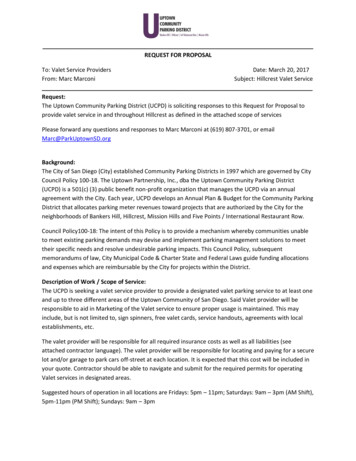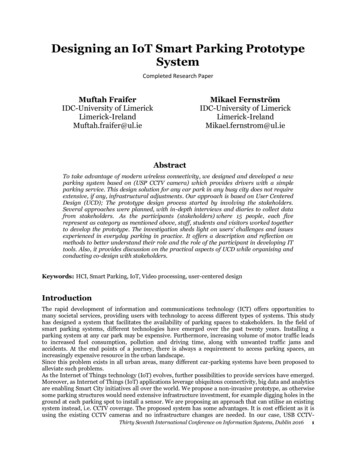
Transcription
Designing an IoT Smart Parking PrototypeSystemCompleted Research PaperMuftah FraiferIDC-University of LimerickLimerick-IrelandMuftah.fraifer@ul.ieMikael FernströmIDC-University of ractTo take advantage of modern wireless connectivity, we designed and developed a newparking system based on (USP CCTV camera) which provides drivers with a simpleparking service. This design solution for any car park in any busy city does not requireextensive, if any, infrastructural adjustments. Our approach is based on User CenteredDesign (UCD); The prototype design process started by involving the stakeholders.Several approaches were planned, with in-depth interviews and diaries to collect datafrom stakeholders. As the participants (stakeholders) where 15 people, each fiverepresent as category as mentioned above, staff, students and visitors worked togetherto develop the prototype. The investigation sheds light on users’ challenges and issuesexperienced in everyday parking in practice. It offers a description and reflection onmethods to better understand their role and the role of the participant in developing ITtools. Also, it provides discussion on the practical aspects of UCD while organising andconducting co-design with stakeholders.Keywords: HCI, Smart Parking, IoT, Video processing, user-centered designIntroductionThe rapid development of information and communications technology (ICT) offers opportunities tomany societal services, providing users with technology to access different types of systems. This studyhas designed a system that facilitates the availability of parking spaces to stakeholders. In the field ofsmart parking systems, different technologies have emerged over the past twenty years. Installing aparking system at any car park may be expensive. Furthermore, increasing volume of motor traffic leadsto increased fuel consumption, pollution and driving time, along with unwanted traffic jams andaccidents. At the end points of a journey, there is always a requirement to access parking spaces, anincreasingly expensive resource in the urban landscape.Since this problem exists in all urban areas, many different car-parking systems have been proposed toalleviate such problems.As the Internet of Things technology (IoT) evolves, further possibilities to provide services have emerged.Moreover, as Internet of Things (IoT) applications leverage ubiquitous connectivity, big data and analyticsare enabling Smart City initiatives all over the world. We propose a non-invasive prototype, as otherwisesome parking structures would need extensive infrastructure investment, for example digging holes in theground at each parking spot to install a sensor. We are proposing an approach that can utilise an existingsystem instead, i.e. CCTV coverage. The proposed system has some advantages. It is cost efficient as it isusing the existing CCTV cameras and no infrastructure changes are needed. In our case, USB CCTVThirty Seventh International Conference on Information Systems, Dublin 20161
cameras were used as CCTVs nodes in outdoor environment. This paper presents a prototype of a low-costand flexible smart parking monitoring system using an embedded system micro-controller (Intel Galileoboard- Gen 2), with IP connectivity for accessing and controlling devices and appliances remotely.Background Literature and Related WorkIn this section, we review some smart parking systems that fulfil the same purpose with a differenttechnology. Zheng et al (2006) developed a system using crossbow motes, which have a low unit cost, toenable a car detecting entry to the car park and efficiently guiding the driver to an empty parking spacethrough signs displayed to the driver. Funck et al (2004) proposed a system that uses CCTV cameras thatare fitted in car-parks to automatically detect car parking spaces. Also Fraifer and Fernström (2014)proposed smart car parking prototype using camera nodes and OpenCV algorithm to detect the parkedcars to facilitate the service to the users. Panayappan et al (2007) described a parking system in VANETthat locates available parking spaces; this system depends on roadside units deployed to relay parkingmessages and GPS to locate parking positions. Pala and Nihat (2007) used RFID technology. Kianpishehet al (2012) presented a smart parking system using an ultrasonic detector, with one sensor fixed in theceiling above each parking space. Mathur et al (2009) discussed the research challenges relating toparking technology and proposed some possible solutions. In a centralized solution, cars are equippedwith ultrasonic sensors, and when driving past parking spaces they collect occupancy data and upload thedata to the centralized database. The cars that want to park query the centralized database. Hazrin et al(2010) proposed a smart parking system using SMS, A parking reservation system was developed so thatusers could book their parking spots via SMS and using GPS. Bong at el (2008) developed a system toacquire car-park occupancy information using an integrated approach of image processing algorithms,called Car-Park Occupancy Information System (COINS). Klappenecker et al (2014) modelled a parkinglot as a continuous-time Markov chain. The parking area was modelled as a grid, and schemes forinformation aggregation and dissemination over the grid were proposed. Jian et al (2008) proposed asystem containing a Gate-PC Controller and Embedded Gate Hardware, an RFID System and a ModularParking Management Platform. Most systems in the Modular RFID Parking Management System couldbe substituted for any other similar subsystem. Lee et al (2016) proposed the use of a combination ofmagnetic and ultrasonic sensors for accurate and reliable detection of vehicles in a parking lot, and alsodescribed a modified version of the min-max algorithm for the detection of vehicles using magnetometers.Many different forms of communication technologies have been used in smart parking systems, e.g.WSNs, ZIGBEE, IEEE802.15.4, RFID, NFC, Bluetooth.For an overview of the reviewed systems, see Table 1.Table 1. Overview of smart parking systems based on different techniquesTechnology FIDHighComplexCCTVsHighSimpleLight sensorHighComplexAccurate at day time Cannot be used atnightAcoustic sensorHighComplexSeriously influenced by environmentalnoiseAccurateFalse detection may occurThirty Seventh International Conference on Information Systems, Dublin 20162
Optical sensorHighComplexVery AccurateMagnetic sensorsHighSimpleAccurateInfrared IRHighSimpleToo sensitive (Maximum accurate daytime)Table 1. smart parking systems and different techniquesResearch MethodologyOur approach is based on User Centered Design (UCD). It involves designing an Interactive Technology(IT) smart parking system with stakeholders and utilizing the infrastructure of a car park of anyorganisation. This is carried out in parallel with technical probes. Also, motivations through UCD designobservation and survey and in depth interviews with stakeholders are outlined. In this paper, weare monitoring actual parking spaces and explore the desired services informed and shaped by our usergroups (stakeholders), using open source software as much as possible.The prototype design process started by involving stakeholders. Several iterations are being planned. Thisalso illustrates how the different methods help to inform the design. We are designing from the users’perspective (UCD), while having the users included in the design phase of the mobile app (PD), and forthe ethnographic approach we are making observations (UCD). This design framework focusses on theneeds, desires, and limitations of stakeholders at each stage of the design of a product or service. Thismethod has been applied to design a system prototype (IoTcam and server). While focusing on the user'sactive involvement and participation in design process, several iterations are being planned to redesignand evaluate the prototype, as following:i.In-depth interviews with stakeholders were conducted in The Interaction Design Centre (IDC).These in-depth interviews are a qualitative method of analysis, a semi-structuredconversation between the interviewer and respondent.ii. Diary Studies, a longitudinal technique used in Anthropology and User Experience research tocapture data from stakeholders, were carried out. Some diaries have been completed whilesome are still in use by stakeholders.iii. Design Workshop Sessions will present an informal space for sharing skills and ideas, exploringprocesses to evaluate the performance of the prototype.User-Centred Design and Its Influence on Our PrototypeThis research study is carried out to explore the approach of user-centred design, with a focus onstakeholders’ involvement in the development of a smart parking technology prototype. It has becomeusual for a driver to spend a large part of his time just minutes looking for a place to stop his car and standin unwanted place, which is a fee parking place, which would be avoided by the students usually. Includestress and anger, in addition to the greater consumption of fuel while idling. Which many drivers do notcare and do not aware too. The societal and economic costs of this scourge are vast and increasing rapidly.We tried to alleviate this everyday issue through the proposed prototype. Although it is only in the earlyThirty Seventh International Conference on Information Systems, Dublin 20163
stages there is no need to change the infrastructure, although some stakeholders suggested a few thingsmay involve some costs. The stakeholders have been identified and a thorough investigation of theirneeds has been conducted. By performing tasks and needs analyses, designers can develop alternativedesign solutions to be evaluated by users. The data analysis was based on a qualitative content analysisfrom a human-computer interaction perspective.(UCD) methodology in this process is used as a framework of processes in which the needs of stakeholdersof a product or service are given extensive attention at each stage of the design process. It begins bydefining the problem, which in our case is congestion during peak times and it is the effect on the driversas it appears as difficult to find a parking spot for the driver accordingly. Information is then collectedfrom the stakeholders to get more ideas about the problem and how they feel about it (in our case wedeliver some information about the phenomena and how should react to it.) and then build a test modeland for each time go back to stakeholders to evaluate the porotype until improve the service and theprototype.System Contribution and Design GoalsBased on our literature review and having access to the existing infrastructure on campus, we set out toexplore a smart parking system based on camera nodes that can provide drivers with a parkinginformation service. It should provide real-time navigation support to the driver. It should provide afriendly parking information service to both the parking user and the parking facility’s operator/owner.Using CCTV camera nodes for this purpose as well as for security purposes is an economical option.Based on our literature review and having access to the existing infrastructure on campus, we set out toexplore a smart parking system based on camera nodes that can provide drivers with a parkinginformation service. It should provide real-time navigation support to the driver, for example by utilisingGoogle maps. It should provide a friendly parking information service to both the parking user and theparking facility’s operator/owner. Using CCTV camera nodes for this purpose as well as for securitypurposes is an economical option.Moreover, through the usage of the (UCD); we have been able to include features that the stakeholdersdeemed important and that would drive them to use the system, as the main function the system is togather information about parking status in real time, and help drivers to navigate directly to vacantparking spaces. In this scenario, we develop a prototype inspired by ourselves (authors) as the firstcornerstone and then, following the methodology of UCD, use stakeholders for each stage as many ideaswere inspired by them when build a model. For each stage, we go back to the stakeholders to get feedbackabout the prototype and to test the prototype in different aspects such as usability and feasibility and toget more ideas about improving the prototype to help us to improve the service and of course to solve theissue of making the driver turn around to find the best parking space or at least let them know that there’sno need for searching for parking spaces.This approach was used for listening to stakeholders to discuss an alternative design which can enhancedesigners’ understanding of the intended purpose(s) of the prototype and may provide information thatdoes not come out of initial interviews, observations, and needs analysis. It is only through feedbackcollected in an interactive iterative process involving users that products can be refined. The lesson welearned is that the most valuable form of feedback is through evaluating design solutions withstakeholders, as we got several ideas on how to improve the prototype, which at least alleviates the issueof unnecessary idling when searching for a parking spot.Thirty Seventh International Conference on Information Systems, Dublin 20164
Ideas from Stakeholders Used to Improve the Prototype:. Some suggested letting all the drivers know about the fully equipped parking spots via largeinformation screens. Use small screens at each parking (space/area) to help to avoid crowding and congestion. Use large screens at each entrance to the university to provide information to the drivers. The user should be able to click on a button to confirm that he/she has arrived through
parking system based on (USP CCTV camera) which provides drivers with a simple parking service. This design solution for any car park in any busy city does not require extensive, if any, infrastructural adjustments. Our approach is based on User Centered Design (UCD); The prototype design process started by involving the stakeholders. Several approaches were planned, with in-depth interviews .
